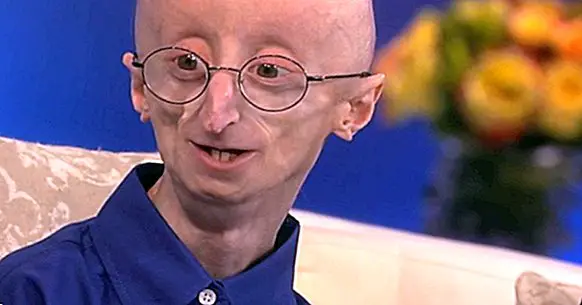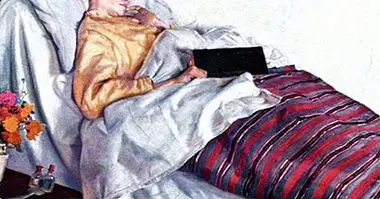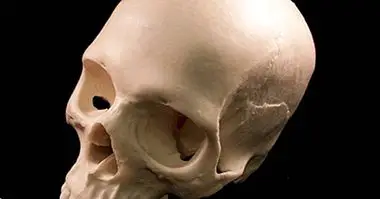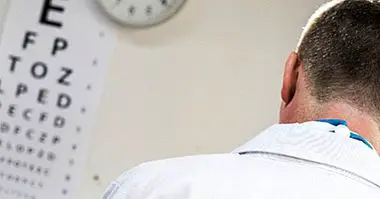Progeria: causes, symptoms and treatment
Since it was first described in 1886, progeria has become a well-known disease due to a peculiar fact: children with this severe disorder seem to age very quickly and present signs similar to those of old age. In this article we will explain what are the symptoms, causes and treatment of progeria .
- You may be interested: "The differences between syndrome, disorder and disease"
What is progeria?
Progeria is a disease of genetic origin that causes an accelerated and premature aging in boys and girls who suffer The word "progeria" comes from the Greek and could be roughly translated as "premature old age".
This disorder is also known as "Hutchinson-Gilford progeria syndrome" in honor of Jonathan Hutchinson and Hastings Gilford, who described it independently at the end of the 19th century.
It is a very rare disease in the world population: it is estimated that appears in approximately 1 in every 4 million births . Throughout the history of medicine there have been about 140 cases of Progeria, although it is believed that there could be a similar number of people affected worldwide at present.
Most people affected by progeria die prematurely. The average life expectancy is around 14 or 15 years , although some patients survive for more than 20 years. With great frequency the death is due to heart attacks and strokes associated with alterations in the circulatory system.
- You may be interested: "Edwards syndrome (trisomy 18): causes, symptoms and types"
Symptoms and main signs
Girls and boys affected by Progeria often have a normal appearance during the months following birth. However, its rate of growth and weight gain soon becomes less than that of other children, and the rate of aging seems to multiply by 10.
Likewise characteristic facial features appear like a thin nose and finished in peak, thin lips and eyes and prominent ears. The face tends to be thinner, narrower and wrinkled than the rest of the girls and boys; Something similar happens with the skin as a whole, which looks aged and also shows a deficit of subcutaneous fat.
It is also very common to give other signs reminiscent of aging, such as hair loss and the appearance of malformations in the joints. However, the intellectual development and the motor are not affected , so that children with Progeria can have an almost normal operation.
The cardiovascular alterations characteristic of Progeria, which are manifested mainly in the presence of atherosclerosis and worsen significantly as the development progresses, are the fundamental sign to understand the short life expectancy of people with Progeria.
Thus, in a synthetic way, we can say that the most common symptoms and signs of Progeria are the following:
- Delay of growth and weight gain during the first year of life.
- Height and low weight.
- Generalized body weakness due to degeneration of muscles and bones.
- Disproportionately large head size (macrocephaly).
- Alterations in the morphology of the face (e.g. narrower and wrinkled).
- Jaw smaller than normal (micrognathia).
- Loss of hair on the head, on the eyebrows and in the eyelashes (alopecia).
- Development of delayed or nonexistent teeth.
- Weakness, dryness, roughness and fineness of the skin.
- Opening of the fontanels (holes in the skull of babies).
- Decrease in the range of motion of the joints and muscles.
- Early onset of atherosclerosis (hardening of the arteries due to fat accumulation).
- Increased risk of myocardial infarction and stroke .
- Late development of renal alterations.
- Progressive loss of visual acuity.
Causes of this disease
The development of progeria has been associated with random mutations in the LMNA gene , which has the function of synthesizing proteins (mainly lamina A and C) fundamental to create filaments that provide strength and resistance to cell membranes, as well as to shape the nucleus of cells.
Alterations in the LMNA gene make cells, especially their nuclei, more unstable than normal and therefore suffer more frequent damage. This causes them to degenerate more easily and tend to die prematurely. However, it is not known exactly how such a mutation is related to the signs of progeria.
Although it is not usually associated with genetic inheritance, in some cases mutations in the LMNA gene seem to be transmitted from parents to children through an autosomal dominant mechanism.
- Related article: "What is epigenetics? Keys to understanding it"
Treatment
Given that progeria has its origin in genetic mutations, at present there are no effective treatments to modify its manifestations. That is why the management of progeria cases is mainly symptomatic .
The increased risk of heart and cerebrovascular accidents can be combated through the use of medications such as statins (used to reduce cholesterol levels) and acetylsalicylic acid, better known as "aspirin". Sometimes coronary artery bypass surgery is also performed.
Respiratory, skeletal, muscular, renal problems and of other types are handled in a similar way: treating the manifestations without intervening at the genetic level. Although research is being done in this regard, the effectiveness of any therapy for progeria has not been demonstrated at this time.
Bibliographic references:
- Gilford, H. & Shepherd, R. C. (1904). Ateleiosis and progeria: continuous youth and premature old age. British Medical Journal, 2 (5157): 914-8.
- Gordon, L. B .; Brown, W. T. & Collins, F. S. (2015). Hutchinson-Gilford progeria syndrome. Gene Reviews. Retrieved on July 4, 2017 from //www.ncbi.nlm.nih.gov/books/NBK1121/
- Hutchinson, J. (1886). Case of congenital absence of hair, with atrophic condition of the skin and its appendages, in a boy whose mother had been almost wholly bald from alopecia areata from the age of six. Lancet, 1 (3272): 923.



















